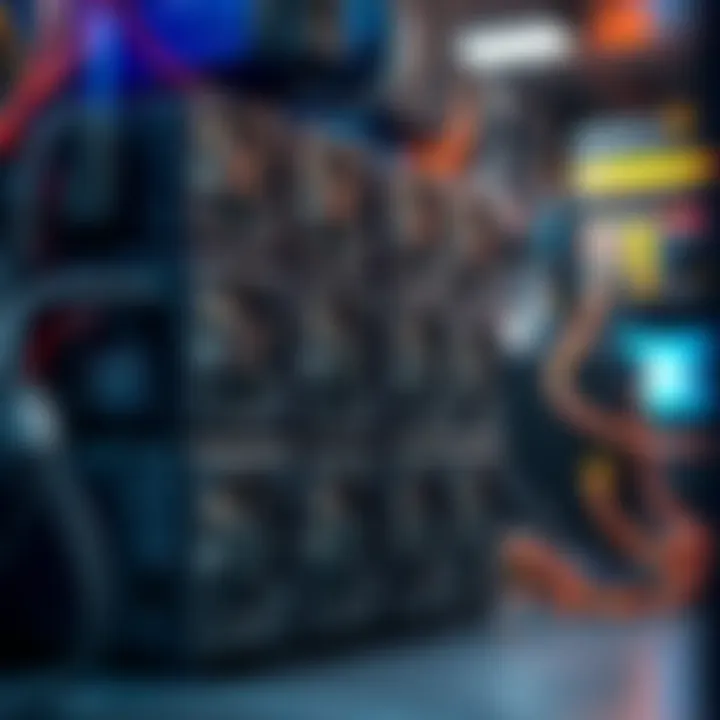Mining Rig Hardware Insights: Specs and Performance


Intro
In the rapidly evolving landscape of cryptocurrency, the importance of mining rig hardware cannot be overstated. As the backbone of every cryptocurrency network, mining rigs are crucial for validating transactions and maintaining the integrity of various blockchains. Lately, the conversation surrounding mining hardware has shifted, focusing not just on performance but on the intricate details that dictate efficiency and profitability. In this analysis, we’ll delve into the nitty-gritty of mining rig components, how they connect to the broader market trends, and the innovations that continue to shape the mining environment.
Gaining insight into these themes can be particularly valuable for potential investors, tech enthusiasts, and academics. Engaging with current trends and understanding the latest technologies not only aids in making informed decisions but can also reveal the evolving nature of cryptocurrency and blockchain technologies.
Market Insights
To fully grasp the dynamics of mining hardware, we must first explore the current state of the cryptocurrency markets. The fluctuations and movements within this realm offer a window into what mining rig specifications are becoming desirable.
Current Trends in Cryptocurrency Markets
Cryptocurrency markets have witnessed intense activity recently, with certain coins experiencing meteoric rises in both value and public interest. However, it’s not just the coins themselves that are significant; the hardware used to mine these currencies is experiencing transformations as well. Here are a few notable trends:
- Adoption of ASIC Miners: Specialized Application-Specific Integrated Circuits (ASICs) are dominating the scene. These devices offer tailored performance, designed solely for mining specific coins. Their efficiency can drastically reduce power consumption compared to traditional graphics processing units (GPUs).
- Green Mining Initiatives: As concerns over electricity consumption rise, there is a movement towards eco-friendly mining. Hardware designed for sustainability, using renewable energy sources, is gaining traction, aligning with societal values and often resulting in lower operating costs.
- Strategic Geographic Locations: Miners are increasingly relocating to areas where electricity is cheaper or renewable energy options are abundant. This shift not only enhances profitability but also curtails the ecological footprint of mining activities.
Key Indicators for Market Analysis
When evaluating how mining rig hardware trends correlate with market performance, consider the following indicators:
- Hashrate Trends: Higher hashrates indicate more powerful rigs are needed, as competition intensifies.
- Coin Market Prices: The more valuable a coin, the more incentive miners have to invest in top-tier hardware.
- Difficulty Levels: An increase in mining difficulty can prompt an upgrade in rig components, driving demand for more advanced hardware.
"Understanding these indicators allows miners and investors to gauge the viability of their hardware investments."
Blockchain Innovations
The mining landscape is inextricably linked to innovations within blockchain technology, which directly affects how mining rigs are designed and utilized. Keeping your finger on the pulse of these innovations gives a clearer picture of future trends in hardware requirements.
Emerging Blockchain Technologies
The rise of new blockchains has ushered in novel consensus mechanisms, each with different hardware needs. Notable technologies include:
- Proof of Stake (PoS): Many new projects are opting for PoS over traditional Proof of Work (PoW), which might diminish reliance on heavy mining rigs.
- Layer 2 Solutions: These technologies, like the Lightning Network for Bitcoin, are attempting to alleviate the burden on main chains, potentially impacting the demand for mining hardware even further.
Real-world Applications of Blockchain
As we look at advancements, it’s clear: the mining hardware landscape is shaped by practical use cases of blockchain technology. From supply chain transparency to securing digital identity frameworks, understanding how these applications proliferate can inform hardware trends.
As the cryptocurrency and blockchain arenas continue to shift, those invested in mining hardware must remain vigilant about performance, compatibility, and ongoing advancements. This knowledge is not merely academic; it is a compass guiding critical decisions in an ever-changing market.
Foreword to Mining Rig Hardware
In the ever-evolving landscape of cryptocurrency, mining rigs stand out as the backbone of the operation. The significance of this hardware isn't merely rooted in technical specifications; it's woven into the very fabric of how cryptocurrencies are created and transacted. Whether you are a seasoned investor, a tech aficionado, or navigating these unfamiliar waters, understanding mining rig hardware is paramount.
Mining rigs, at their core, are specialized computers designed to validate transactions on a blockchain network. They perform complex calculations that support the consensus algorithms, maintaining the integrity of the digital currency ecosystem. The efficiency and power of these rigs can directly influence the outcome of a miner's returns, thus shaping the broader profitability of cryptocurrency ventures.
Definition of Mining Rigs
So, what exactly are mining rigs? Simply put, a mining rig is a setup that combines various components to extract cryptocurrency through mining processes. They traditionally consist of several crucial elements, including graphics processing units (GPUs), application-specific integrated circuits (ASICs), motherboards, and other peripherals like power supply units.
Most notable in this mix are GPUs and ASICs. While GPUs are versatile and can mine a range of currencies, ASICs are optimized for speed and efficiency in mining a specific currency. For example, a rig might consist of four high-end GPUs linked together, typically housed within a sturdy frame. In contrast, an ASIC miner could resemble a small box, efficient yet singularly focused on its mining objective.
Importance of Hardware in Cryptocurrency Mining
The discussion around hardware in cryptocurrency mining transcends just the components; it delves into the implications for success and sustainability in mining operations. The performance of the mining rig can determine the rate of coin production and, as such, links directly to profitability. Here are a few reasons why the right hardware is crucial:
- Hash Rate Efficiency: A miner's success hinges on the hash rate—the speed at which computations are completed. Higher hash rates mean better chances of solving blockchain puzzles faster.
- Energy Consumption: Mining is energy-intensive. The right hardware will balance performance with energy efficiency, which becomes increasingly important as electricity costs rise.
- Longevity and Maintenance: Investing in robust mining hardware can extend its operational life, reducing costs associated with repairs and replacements.
"The right mining rig isn't just a tool; it's a potential profit generator that can make or break a mining strategy."
In summary, the implications of mining rig hardware stretch beyond mere technical specs; they encapsulate the entire mining experience. As we delve further into the components, selection criteria, and trends in mining hardware technology, a stronger grasp of this foundation will not only help in hardware decisions but is also essential for maximizing profitability in the highly competitive world of cryptocurrency.
Key Components of Mining Rigs


Understanding the key components of mining rigs is fundamental to building, optimizing, and maintaining a successful cryptocurrency mining operation. Each component holds significance, affecting the performance, efficiency, and, ultimately, the profitability of the mining process. In a landscape where technology is rapidly evolving, being informed about these components not only informs better purchasing decisions but also enhances the long-term viability of your investments in mining hardware.
Graphics Processing Units (GPUs)
Graphics Processing Units, or GPUs, are arguably the heart of most mining rigs today. Unlike traditional CPUs, which are designed for general use, GPUs excel at parallel processing, meaning they can perform multiple operations at once. This makes them particularly effective for running the complex algorithms that underpin cryptocurrencies like Ethereum.
- Power and Performance: High-performance GPUs, such as the NVIDIA GeForce RTX 3080 or AMD Radeon RX 6800, are highly sought after in mining due to their exceptional hashing power. A GPU’s ability to produce a high hash rate means it can solve equations faster, leading to better performance in a competitive mining environment.
- Memory Considerations: The amount of memory (VRAM) is also crucial, as certain algorithms require more memory to function optimally. Opting for models with 8GB or more can future-proof your rig against upcoming updates in blockchain technology.
Properly configuring GPUs, including adjusting the power limits and core clock settings, can yield significant returns. However, care must be taken to avoid overheating, which could throttle performance or damage the hardware.
Application-Specific Integrated Circuits (ASICs)
While GPUs dominate in versatility, Application-Specific Integrated Circuits (ASICs) represent the pinnacle of efficiency for singularly focused mining tasks. Designed solely for the purpose of cryptocurrency mining, ASICs like the Bitmain Antminer S19 Pro are matched for specific algorithms and outshine GPUs in raw hashing power.
- Efficiency: ASICs provide optimal energy use, translating computational power into actual mining rewards without the excessive energy overheads seen in GPU setups. This characteristic is especially vital in regions with high electricity costs.
- Limited Scope: However, the downside is that ASICs are not versatile. An ASIC can only mine the specific coins for which it was developed. This limits flexibility but generally maximizes profitability in targeted mining scenarios.
Motherboards and CPUs
The motherboard and CPU, while not as flashy as GPUs or ASICs, play a pivotal role in the integration and functionality of your mining setup. The motherboard is like the nervous system of the rig, allowing communication among components.
- Choosing the Right Motherboard: When selecting a motherboard, it's essential to pick one that can support multiple GPUs for those wishing to expand the rig. Models like the ASUS B250 Mining Expert or MSI's Z390-A PRO can accommodate several GPUs.
- CPUs – The Backbone: A strong, compatible CPU, while it doesn’t need to be top-tier, ensures the rig runs smoothly without bottlenecks during operation. An Intel i3 or Ryzen 3 can suffice for everyday mining tasks.
Power Supply Units (PSUs)
Power supply units are indispensable to the operation of mining rigs. After all, powerful components like GPUs and ASICs require an equally robust power source to function optimally.
- Wattage and Efficiency: It is vital to select a PSU with sufficient wattage to handle peak power demands, typically ensuring at least a 20% overhead.
- Efficiency Ratings: Look for PSUs with an 80 PLUS certification, which signifies efficient power use. Higher-rated PSUs not only save electricity but also result in lower operational costs.
Cooling Systems
Mining hardware generates a lot of heat, and temperature management is critical to ensuring the longevity and efficiency of your equipment. The cooling system can make or break a mining rig.
- Air vs. Liquid Cooling: Although many miners depend on standard air cooling solutions like fans, liquid cooling systems offer advanced temperature control. Fans can circulate air effectively, but liquid cooling might be necessary for high-end rigs operating at full capacity.
- Ventilation Importance: Maintaining good airflow in the mining space is essential. A cramped setup can lead to overheating and subsequent system failures. Ensuring physical spacing between components for adequate airflow can significantly reduce overheating issues.
Investing in the right components is not just about immediate performance; it’s also about sustaining long-term mining operations. Choosing wisely will save headaches in maintenance and increase overall profitability in a volatile market.
Selecting the Right Mining Rig for Your Needs
Finding the correct mining rig can feel like searching for a needle in a haystack, especially given how the marketplace evolves daily. The demands and challenges of cryptocurrency mining require a thoughtful approach when selecting hardware. The decision impacts not only your efficiency but also your overall return on investment.
Evaluating Mining Goals
Before you hand over any cash, it’s crucial to take a step back and evaluate your mining goals. Ask yourself: Are you in it for the long haul or just dipping your toes in the water?
- Long-Term Investment: If you're planning to build a mining empire from the ground up, opt for robust hardware that promises longevity and efficiency.
- Short-Term Gains: For those looking to profit quickly, portable and less expensive rigs may suffice, albeit with reduced performance.
- Cryptocurrency Focus: Each coin has its unique demanding algorithm and profitability potential. Tailor your hardware choice according to the specific coin you target.
Cost-Benefit Analysis of Mining Hardware
It’s not just about what you want, but what you can afford. A meticulous cost-benefit analysis allows you to determine what’s worth investing in.
- Initial Investments: Factor in everything from GPUs to PSUs. A high-end GPU might offer performance like a Ferrari, but not everyone needs to drive at that speed.
- Operating Costs: Keep an eye on electricity bills and cooling systems; they can eat into your profits faster than you think.
- Return on Investment: Calculate an expected payout period. With the right gear, your rig may start paying you back in weeks rather than months.
Assessing Power Efficiency
Power consumption can sometimes fly under the radar but it’s a heavy hitter regarding overall profitability. The efficiency of a mining rig relates directly to how much power it consumes versus the output it generates.
- Wattage Ratings: Ensure your components align to achieve optimal performance per watt. This will help keep electricity costs manageable.
- Energy-Efficient Models: Models like NVIDIA's 30 series often provide better power efficiency compared to older generations. Do thorough comparisons before rushing to buy.
Compatibility with Mining Software
Even the fanciest rig won’t get far if it doesn’t play well with mining software. All the bells and whistles won’t matter if your selected software doesn't mesh with your hardware.
- Research Compatibility: Not all mining software supports every hardware setup. Review forums or technical documentation beforehand.
- Updates: Choose gear that can easily adapt as updates roll out in software. The last thing you want is a cutting-edge mining rig made moot by outdated software.
In summary, selecting the right mining rig isn't a matter of just filling a shopping cart with high-priced parts. It's akin to building a finely tuned machine. With a little legwork to evaluate goals, crunch numbers, and ensure software alignment, you can set yourself on a path toward successful mining.


Current Trends in Mining Hardware Technology
In the fast-paced world of cryptocurrency mining, staying updated with current trends in mining hardware technology is essential. The landscape is constantly evolving, influenced by various factors including market demand, technological advancements, and regulatory changes. Understanding these trends helps investors, tech enthusiasts, and academics navigate the complexities of mining operations effectively. Today's miners need to be aware of not just the hardware they use but also the paradigms shaping these technologies.
Emerging Technologies in Mining
The emergence of new technologies in mining hardware has brought about significant changes that enhance productivity and efficiency. For instance, sharply designed ASIC miners are shaping the narrative of computational power. These specialized chips are tailored specifically for mining certain cryptocurrencies, significantly increasing hash rates while reducing power consumption. The push for higher efficiency and lower environmental impact is driving innovations in cooling systems as well. Technologies like immersion cooling are catching attention by submerging hardware into a non-conductive liquid, which optimizes cooling and maximizes hardware longevity.
Moreover, the integration of artificial intelligence in mining operations is on the rise. Using AI algorithms, miners can analyze historical data to predict fluctuations in mining profitability. This enables better decision-making regarding when to mine specific coins and when to redirect resources.
As a simple illustration, miners can leverage machine learning to identify the most profitable time to activate or deactivate their rigs based on current electricity prices and token valuations.
"In mining, having the right hardware can mean the difference between profit and loss. Emerging technologies enhance this hardware, making it crucial to stay ahead of trends."
The Rise of Cloud Mining Solutions
Cloud mining solutions provide an intriguing alternative to traditional hardware setups. Instead of managing their own equipment, users can rent hashing power from a centralized facility. This approach presents several benefits:
- Cost Savings: Users don’t need to invest heavily in expensive hardware and can avoid maintenance costs.
- Accessibility: Individuals without technical expertise can join the mining game, democratizing access.
- Scalability: Users can easily adjust their mining capabilities according to market conditions.
However, cloud mining comes with its caveats. Many services have been associated with scams or unregulated practices, making due diligence essential for potential investors. Before jumping in, it’s wise to research reputation, contracts, and performance metrics of any cloud mining provider.
In summary, cloud mining offers a potentially less cumbersome approach to engaging in cryptocurrency mining, but it requires scrutiny. Evaluating contractual commitments and understanding operational risks should be priority considerations. As the future unfolds, the interplay between traditional hardware and cloud solutions will likely redefine mining strategies overall.
Building Your Own Mining Rig
Building your own mining rig can feel like diving into the deep end of a pool without checking the water first. Yet, with careful consideration and understanding, it becomes a rewarding venture that not only caters to your specific needs but might also boost your profitability in the cryptocurrency world. This section delves into the importance of constructing a mining rig from the ground up, along with the several benefits it brings as well as key considerations that ought to be kept in mind.
Step-by-Step Guide to Rig Assembly
When it comes to assembling your mining rig, a step-by-step approach can make the process significantly smoother. Let’s break it down:
- Choosing the Right Components: Start by selecting quality components that suit your mining goals. You’ll need a reliable motherboard, suitable GPU or ASIC, an adequate PSU, and a cooling system. Double-check compatibility among the parts before making any purchase.
- Prepare Your Workspace: A clean, static-free environment is key. Gather tools including screwdrivers, anti-static wrist straps, and perhaps even a mat where you can lay out components.
- Install the Motherboard: Secure your motherboard onto the open rig frame or case. Make sure it’s stable and all screw holes are aligned properly.
- Add CPU and RAM: Gently place the CPU into its socket, aligning it correctly, then secure it. Follow with the installation of RAM sticks according to the motherboard manual.
- Insert the GPU(s): Slot the GPU into the PCIe connectors firmly. If using multiple GPUs, ensure there’s adequate spacing to prevent overheating.
- Plug in Power Supply: Connect all required cables from the PSU to the motherboard and other hardware. Take your time here; precise connections reduce the chance for failures.
- Cooling Setup: Proper cooling keeps your rig running efficiently. Attach fans or any cooling system you decided on, ensuring airflow isn’t obstructed.
- Final Checks and Power-Up: Before plugging everything in, double-check your connections. After that, it’s time to power it up! Watch for any issues right away.
By following this methodical approach, you’ll have laid a strong foundation for success in your mining endeavors.
Common Mistakes to Avoid
Navigating the path of building your own mining rig comes with its own set of pitfalls. Being aware of these missteps can save you both time and money:
- Ignoring Power Needs: Many new builders overlook the power demands of the GPUs or ASICs they select. Always calculate potential electricity usage to avoid burnout.
- Overheating: Skipping on a cooling system might seem cost-effective but could lead to excessive wear on components. Maintain proper airflow and consider extra fans.
- Neglecting Software Compatibility: Not all mining software works seamlessly with all hardware. Before finalizing purchases, ensure that the chosen software aligns with your setup.
- Underestimating Time for Setup: Rushing the assembly can result in mistakes. Allocate enough time for a proper build and testing phase.
- Forgetting About Future Upgrades: Building with the future in mind can save headaches down the road. Consider what components will be easy to upgrade as technology advances.
A well-thought-out rig is more than just a cluster of components; it’s an investment in your financial future.
Overall, constructing a mining rig on your own can seem daunting but following the steps and being aware of common pitfalls makes it a more approachable task. Investing the necessary time and effort into the assembly process can yield significant returns as you navigate through the dynamic landscape of cryptocurrency mining.
Maintenance and Troubleshooting of Mining Rigs
Maintaining a mining rig is not just about keeping the lights on; it's akin to nurturing a fine piece of machinery that requires regular attention for optimal performance. A well-maintained rig can make the difference between running profitably and finding yourself in the red. Given the high stakes involved in cryptocurrency mining, understanding the ins and outs of maintenance and troubleshooting is paramount for miners, whether they're just starting out or are seasoned pros.
Regular upkeep of mining rigs can help in prolonging their lifespan, boosting their efficiency, and safeguarding them from untimely failures. Ignoring maintenance can lead to a cascade of issues that not only affect the hardware components but can also create a loop of escalating costs. For instance, without proper cooling, you could end up burning out your graphics cards or ASICs, leading to hefty replacements.
In this section, we'll delve into the routine maintenance practices and common troubleshooting techniques that any miner should incorporate into their financial mining equation.
Routine Maintenance Practices
Regular maintenance practices are like good habits for your mining rig – the more you follow through, the better your rig performs.
- Dusting and Cleaning: Dust accumulation can lead to overheating and reduced performance. Regularly clean the components using compressed air or a soft brush. Make sure to keep the rig in a dust-free environment as much as possible.
- Monitoring Temperature: Keep an eye on the temperature of the GPUs or ASICs. Too high temperatures can reduce performance or even cause damage. Consider implementing monitoring software that gives real-time feedback on heat levels like HWMonitor or MSI Afterburner.
- Cable Management: Clutter can restrict airflow, exacerbating overheating issues. Organize cables neatly to encourage better ventilation. Not only does it help in maintaining temperature, but it also makes troubleshooting easier.
- Software Updates: Just like how you keep your smartphone fresh with the latest updates, your mining software also needs to be regularly updated. This may include operating systems, drivers, and mining applications which can help optimize performance and alleviate bugs.
- Check Connections: Regularly check that all connections are secure and free from corrosion. Loose cables can lead to intermittent issues that are often challenging to diagnose.
Diagnosing Common Issues
Every miner encounters the occasional hiccup, and the key to overcoming these issues lies in a systematic approach to troubleshooting. Here’s a guide to some common problems and how you might tackle them:


- Rig Not Starting: If your rig doesn’t power up, this could stem from a faulty power supply, loose connections, or a malfunctioning motherboard. Begin by checking the PSU’s functionality, and then inspect for any loose connections across the board.
- Overheating Issues: If the temperature spikes, consider cleaning out the heatsinks and ensuring the fans are operating properly. You could also optimize the case airflow setup to prevent bottlenecks.
- Poor Hash Rate: If you're not hashing at the expected rate, look at your mining software settings or check for any performance hits from background processes. Sometimes, a simple reboot can alleviate these transient issues.
- Driver Conflicts: System instability can arise from driver conflicts or outdated software. You might want to roll back to a previous driver version or ensure all drivers are up to date and compatible with your current mining setup.
"Regular maintenance and a keen understanding of common issues can save miners both time and money in the long run. Keeping your rig running smoothly is not just a good practice; it’s essential for profitability."
In summary, treating your mining rig with the respect it deserves through routine maintenance can minimize risks and maximize productivity. A few extra hours spent on upkeep can reap dividends by enhancing performance and reducing overall operational costs. These practices form the backbone of every successful mining operation, ensuring that you stay one step ahead in the cryptocurrency game.
Impact of Mining Hardware on Profitability
Mining hardware is not just a set of machines working in synchrony; it’s the backbone of any cryptocurrency mining venture. The odds of turning a profit hinge significantly on the specifications and performance of your mining rig. As technology progresses, understanding the impact of mining hardware on profitability becomes essential for anyone looking to dive into this competitive space.
Electricity Costs and Operational Expenses
The cost of electricity is often the elephant in the room when evaluating the profitability of mining operations. Mining requires substantial energy; thus, a significant chunk of income goes right back into powering the rigs. Here are some critical points to consider about electricity costs:
- Electricity Rate: Depending on where you are, rates can vary dramatically. For instance, places like Quebec in Canada are known for their lower prices, while urban areas with high demand could bleed you dry.
- Hardware Efficiency: A newer model of a GPU or ASIC can perform more computations per watt of electricity than older models. This means while the upfront cost might be higher, the power consumed is generally lower, creating a more favorable balance.
- Cooling Needs: Effective cooling solutions are not just for longevity; they also impact operational costs. If your rigs overheat, you may find yourself spending even more on energy for cooling systems.
By keeping these factors in mind, miners can sketch out a clearer picture of their operational expenses. Here's a nifty breakdown:
- Electricity Costs = Total Wattage * Electricity Rate * Running Hours
- Operational Expenses = Electricity Costs + Maintenance + Internet Costs + Rent (if applicable)
Market Trends Influencing Hardware Choice
The market for mining hardware is as volatile as the cryptocurrencies being mined. Keeping an eye on market trends is key for miners who want to stay ahead of the curve. Here’s how market trends can impact hardware choices:
- Cryptocurrency Valuation: When Bitcoin or Ethereum prices spike, interest in mining often surges, creating higher demands for hardware. This can drive up prices for GPUs and ASICs, which means timing your purchase can save you a pretty penny.
- Emerging Competitors: With newer and more efficient miners entering the field, established miners may find themselves at a disadvantage with outdated hardware. The race to stay relevant requires constant upgrades.
- Regulations and Bans: Different countries may impose regulations on mining activities. For instance, China’s stance against cryptocurrency mining sent shockwaves through the market, leading to changes in hardware availability.
To adapt to the fast-paced mining environment, investors must remain agile—researching not only tools but also forthcoming regulations and market sentiment.
”Staying informed is half the game when it comes to mining hardware.”
All things considered, the interplay between mining hardware and profitability isn’t just a dry subject of numbers; it’s a living, breathing entity that changes with the times and trends. As the landscape of cryptocurrency mining grows, understanding these factors makes for sound investment and operational strategies. Those who take the time to analyze these elements can better navigate their mining journey, turning potential hurdles into stepping stones for success.
Future of Mining Rig Hardware
The landscape of mining rig hardware is undergoing constant evolution, driven by technological advancements and market demands. Understanding this future is crucial for anyone involved in cryptocurrency mining, be it investors, tech enthusiasts, or academic observers. Staying ahead of trends not only affects profitability but also operational sustainability. In this section, we will delve into two significant areas: innovations on the horizon and the pressing need for environmental considerations.
Innovations on the Horizon
As technology accelerates, we see mining rigs becoming more efficient and versatile. Innovations in hardware design and functionality are set to reshape the mining experience significantly. Some advances worth mentioning include:
- AI and Machine Learning Integration: This can optimize mining processes by predicting network difficulty adjustments or enhancing power management.
- Enhanced Cooling Technologies: With rising temperatures, innovative cooling systems like liquid cooling or advanced heat dissipation methods will likely become standard, ensuring rigs operate efficiently without overheating.
- Modular Architectures: Future rigs may adopt modular designs, where users can upgrade specific components without replacing the entire setup. This approach optimizes cost and keeps up with rapidly evolving technology.
- Quantum Computing: Although still in its infancy, the promise of quantum computing could revolutionize blockchain mining by making it exponentially faster.
These innovations don’t merely enhance performance; they can also significantly reduce energy consumption. This could lead to greater profit margins and a more appealing investment landscape. As mining becomes more competitive, the need for efficiency is paramount.
"Embracing innovation isn't just a trend; it’s an absolute must for survival in the mining industry."
Environmental Considerations
With great power comes great responsibility. The environmental impact of mining hardware has come under the microscope in recent years. As the world pushes towards sustainability, the mining community must adapt. Here are some of the pertinent considerations:
- Carbon Footprint: Traditional mining operations are notorious for high energy consumption, often sourced from fossil fuels. Future hardware must aim to utilize renewable energy sources, such as solar or wind, to mitigate this problem.
- E-Waste Management: As tech advances lead to faster obsolescence, dealing with e-waste responsibly becomes essential. Companies that design rigs should integrate recyclable materials and establish take-back programs to ensure old hardware doesn't clutter landfills.
- Regulatory Compliance: As governments implement stricter regulations to combat climate change, staying compliant will be crucial. Hardware manufacturers and miners must stay informed about evolving regulations affecting energy consumption and emissions.
Epilogue
The culmination of this article sheds light on the significance of selecting the right mining rig hardware in the expansive field of cryptocurrency mining. A well-chosen rig can mean the difference between profit and loss, especially in a landscape as volatile as this one. The insights we’ve discussed surrounding component selection, from Graphics Processing Units to power supply units, highlight that each component plays a vital role in the overall performance.
A mining rig is, at its core, an expensive investment, and understanding the balance between costs, efficiency, and output is crucial. It’s not just about having the latest tech; it’s about matching that technology intelligently to your mining goals. As we've seen, energy consumption can significantly erode profits, making it necessary to adopt an approach that evaluates the long-term benefits against initial setup costs.
Furthermore, keeping up-to-date with emerging technologies and market trends empowers miners to adapt their strategies effectively. This is not a stagnant field, and the ability to pivot based on new information and innovations can yield substantial advantages.
Recap of Key Points
- Mining rig hardware directly influences profitability and efficiency.
- Choosing the right components, such as GPUs or ASICs, is essential for achieving optimal performance.
- Understanding your mining goals and conducting a thorough cost-benefit analysis guides hardware selection.
- Energy efficiency should be prioritized to prevent high operational costs.
- The landscape of mining hardware is ever-changing, with innovations affecting how miners operate in the market.
Final Thoughts on Mining Rig Hardware
As we look to the future of cryptocurrency mining, the evolving nature of the technology should not be underestimated. Innovations are boosting performance, but they also introduce new complexities that must be managed. Investors and tech enthusiasts alike stand to benefit from staying informed, not only about the machines they use but also about the broader market dynamics that influence hardware choices.
"In the world of cryptocurrencies, knowledge is power, and that holds especially true for mining rig hardware selection."
For more resources and updates on mining rig technology, you might want to check out Wikipedia or join discussions on Reddit.
Consistently educating yourself not only enhances your operations but also positions you strategically in the competitive world of digital currencies.







